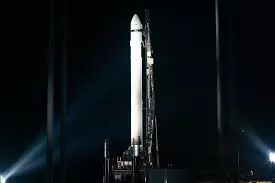Startup Relativity Space sent what it’s calling the “world’s first 3D-printed rocket” toward space on Wednesday, vaulting it into the upper reaches of the atmosphere. Though, it suffered an engine issue after launch and failed to reach orbit.
Terran 1, a 110-foot-tall (33.5-meter) vehicle designed to haul lightweight satellites into orbital space, lifted off from Cape Canaveral Space Force Station on Florida’s eastern coast at just before 11:30 pm ET. The rocket, powered by super-chilled methane and oxygen, burned a bright blue-green against the night sky.
After the first stage of the rocket — the bottommost portion of the rocket that gives the initial thrust at liftoff — expended its fuel, it detached from the rocket’s upper stage. But the engine meant to propel that portion appeared to ignite only briefly, leaving the rocket without enough power to reach orbit.
The mission, nicknamed “Good Luck, Have Fun,” lofted what the company described as a prototype vehicle, along with a hunk of metal — the first object printed by Relativity’s massive 3D printer — as a commemorative token. It was not carrying a client satellite, as will be the case with the company’s future rocket launches.
Relativity had been aiming to get its rocket off the ground earlier in March, but two prior launch attempts were quashed by issues that included getting the propellant to sufficiently cold temperatures, bad weather, and unsatisfactory fuel pressure.

Several hiccups the company faced during its March 11 attempt -— including a boat entering a restricted area within the rocket’s path at sea — came late in the countdown. Another dramatic moment during that attempt ended with the ignition of all nine of the rocket’s engines — but they shut off just moments later, leaving Terran 1 on the pad. The company said computers automatically aborted the launch attempt because of a detected software issue.
Before Wednesday’s event, Relativity cofounder and CEO Tim Ellis had noted in a March 7 Twitter post that he hoped to see the company’s Terran 1 rocket notch a success on its first launch attempt.
“Of course, the rocket-loving engineer in me wants to see us be the first privately-funded AND first liquid-propellant rocket to ever reach orbit on the first try. That would be truly unprecedented,” he tweeted.
But Ellis acknowledged that even watching the rocket clear the launchpad would be a cause for celebration, and that getting the rocket through Max Q — the moment it endures the maximum amount of pressure during flight, about 80 seconds after liftoff — would be a “key inflection” point.
The rocket did successfully achieve that milestone on Wednesday.
Since 2015, Relativity has worked toward developing its first launch vehicle to gauge the success of its founding thesis — that rockets can be quickly, cheaply and efficiently built using additive manufacturing, otherwise known as 3D printing.
Most rockets today rely on some 3D-printed parts, but 85% of Relativity’s Terran 1 rocket is fabricated with this process.















































